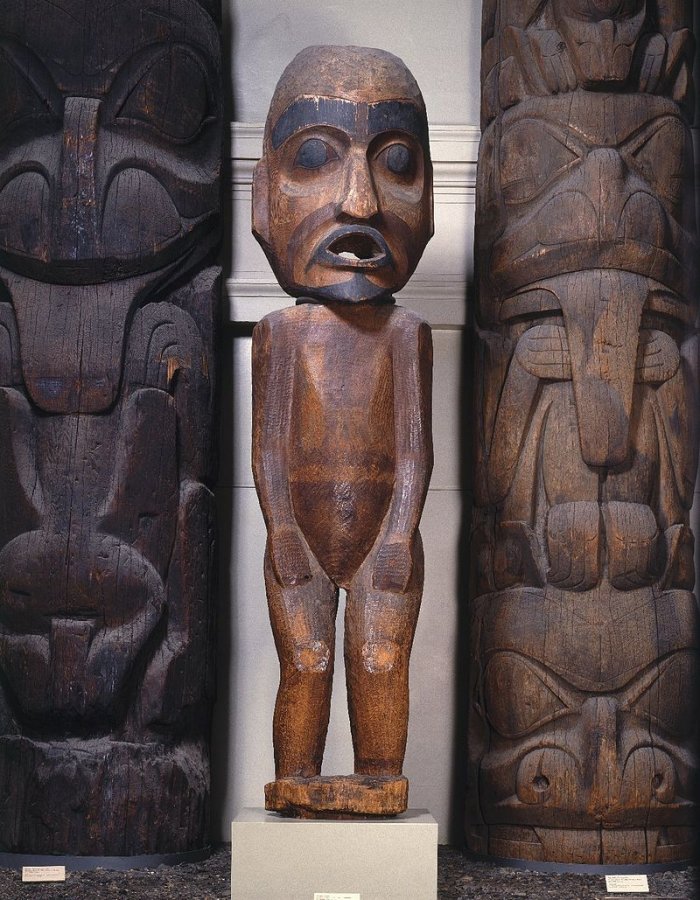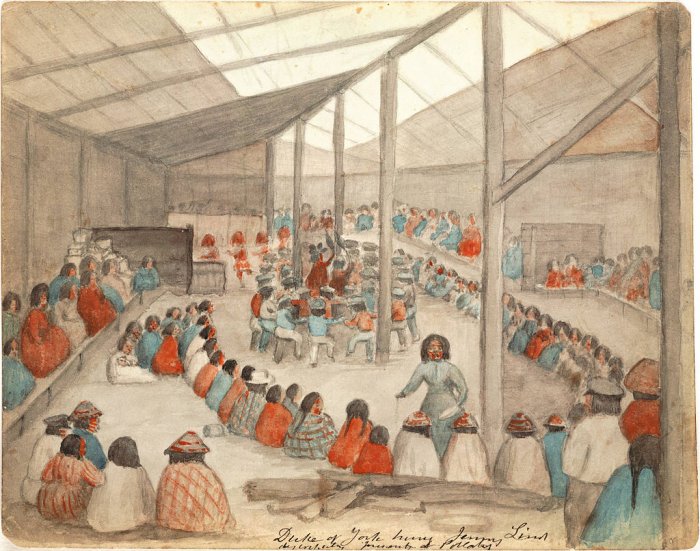Potlatch: Ancient North American Indian Tradition Of Very Generous Gift Giving
AncientPages.com - A Potlatch is an ancient North American Indian tradition of very generous gift giving. A Potlatch was much more than just an ordinary ceremony. Planning a Potlatch could take as long as one year and sometimes even longer.

Speaker Figure, 19th century, Brooklyn Museum, the figure represents a speaker at a potlatch. An orator standing behind the figure would have spoken through its mouth, announcing the names of arriving guests.
The custom was well-known among other ancient civilizations, but the Potlatch custom is mostly associated with Native Americans. It was a ceremonial distribution of property and gifts to affirm or reaffirm social status, as uniquely institutionalized by the American Indians of the Northwest Pacific coast.
The largest Potlatch took place when the queen of Sheba gifted King Solomon 120 talents of gold and the largest quantity of spices ever exchanged at the time.
From 1849 to 1925 the Potlatch reached its most elaborate development among the southern Kwakiutl, North American Indians who traditionally lived in what is now British Columbia, Canada.

Watercolor by James G. Swan depicting the Klallam people of chief Chetzemoka at Port Townsend, with one of Chetzemoka's wives distributing potlatch.
A Potlatch was usually organized because of important events such as marriages, births, deaths, adoptions and initiations into secret societies.
Sometimes trivial events could also result in a Potlatch because the main purpose of a Potlatch was not the occasion itself, but the validation of claims to social rank. The Potlatch was also used as a face-saving device by individuals who had suffered public embarrassment and as a means of competition between rivals in social rank. Only aristocrats could host a Potlatch.
A preparation of a Potlatch involved inviting guests and the size of the gatherings reflected the rank of the donor. Later a speech would be held and the gift giving process started. The distribution of goods by the donor depended on the social rank of the recipients. The proceedings gave wide publicity to the social status of donor and recipients because there were many witnesses. The Potlatch donor strived to be as generous as possible.
For some cultures, such as Kwakwaka'wakw, elaborate and theatrical dances were performed reflecting the hosts' genealogy and cultural wealth. Many of these dances were also sacred ceremonies of secret societies like the hamatsa, or display of family origin from supernatural creatures such as the dzunukwa. According to Kwakwaka’wakw mythology, Dzunukwa is the ‘Wild Woman of the Woods’.
She is often portrayed as an old, unkempt ogress with long, pendulous breasts and wild hair. She is said to snatch up children and carry them home in her basket.
At the end of a Kwakwaka'wakw Potlatch ceremony, the host chief comes out bearing a mask of Dzunuḵ̓wa which is called the geekumhl. This is the sign that the ceremony is over.
From 1884 to 1951 the Potlatches were banned. The Potlatch Ban, which was legislation forbidding the practice of the potlatch was passed by the government of the Dominion of Canada. The Potlatch custom was considered wasteful, reckless and anti-Christian of personal property.
Potlatch was at the heart of a non-Christian cultural system that opposed colonization. Therefore the Potlatch was targeted by missionaries and colonial officials. The Potlatch ban was never entirely effective, though it did significant cultural damage, and continued underground through the period of the ban in a number of places and ways. The Potlatch ban as well as the banning of the Sun Dance and Coast Salish dancing occurred during the height of repressive colonial laws in Canada. In 1951 the Indian Act was amended, removing some of the more repressive measures, including the ban on the potlatch.
After the ban was lifted, Nations on the coast began to openly potlatch again. The revival of open ceremony gained strength during the 1970s and 80s, until it is once again became a widespread and popular tradition.
Copyright © AncientPages.com All rights reserved. This material may not be published, broadcast, rewritten or redistributed in whole or part without the express written permission of AncientPages.com
More From Ancient Pages
-
 Mysterious Anomaly In Earth’s Magnetic Field Documented On 3,000-Year-Old Mesopotamian Bricks
Archaeology | Dec 18, 2023
Mysterious Anomaly In Earth’s Magnetic Field Documented On 3,000-Year-Old Mesopotamian Bricks
Archaeology | Dec 18, 2023 -
 Archaeological Evidence Ancient Egyptians Visited South America
Ancient Mysteries | Jan 7, 2020
Archaeological Evidence Ancient Egyptians Visited South America
Ancient Mysteries | Jan 7, 2020 -
 World’s Oldest Known Cave Painting – 45,000-Year-Old Depiction Of Wild Pig Discovered At Leang Tedongnge Cave
Archaeology | Jan 14, 2021
World’s Oldest Known Cave Painting – 45,000-Year-Old Depiction Of Wild Pig Discovered At Leang Tedongnge Cave
Archaeology | Jan 14, 2021 -
 Urukagina: Ruler Of Sumerian City Of Lagash And His Reforms To Combat Corruption
Civilizations | May 18, 2017
Urukagina: Ruler Of Sumerian City Of Lagash And His Reforms To Combat Corruption
Civilizations | May 18, 2017 -
 Amazing New Frescoes With Mythological Individuals Discovered At Pompeii
Archaeology | Apr 11, 2024
Amazing New Frescoes With Mythological Individuals Discovered At Pompeii
Archaeology | Apr 11, 2024 -
 Mystery Of The British Pompeii Deepens – Bronze Age Settlement Destroyed By Dramatic Fire
Archaeology | Jun 23, 2019
Mystery Of The British Pompeii Deepens – Bronze Age Settlement Destroyed By Dramatic Fire
Archaeology | Jun 23, 2019 -
 Bonobos And Chimps: What Our Closest Relatives Tell Us About Humans
Featured Stories | Apr 6, 2023
Bonobos And Chimps: What Our Closest Relatives Tell Us About Humans
Featured Stories | Apr 6, 2023 -
 5,000-Year-Old Perga City And Kommagene Civilization: Most Of Treasures Are Still Underground
Archaeology | Dec 30, 2017
5,000-Year-Old Perga City And Kommagene Civilization: Most Of Treasures Are Still Underground
Archaeology | Dec 30, 2017 -
 Mystery Of The Coso Artifact: A Spark Plug Or A Genuine Example Of Advanced Antediluvian Technology?
Ancient Technology | Sep 9, 2014
Mystery Of The Coso Artifact: A Spark Plug Or A Genuine Example Of Advanced Antediluvian Technology?
Ancient Technology | Sep 9, 2014 -
 Discovery Of Ancient Sarcophagus And 14 Stone Pillars Covered With Inscriptions In Eastern Mongolia
Archaeology | Dec 22, 2017
Discovery Of Ancient Sarcophagus And 14 Stone Pillars Covered With Inscriptions In Eastern Mongolia
Archaeology | Dec 22, 2017 -
 Egyptian Artisans In The Valley Of The Kings Had Permanent Jobs In The Time Of The Pharaohs
Featured Stories | Apr 11, 2022
Egyptian Artisans In The Valley Of The Kings Had Permanent Jobs In The Time Of The Pharaohs
Featured Stories | Apr 11, 2022 -
 Ancient Manuscript And Controversial Ancient Book Shed New Light On The Mystery Of The Toltecs
Ancient Mysteries | Sep 9, 2018
Ancient Manuscript And Controversial Ancient Book Shed New Light On The Mystery Of The Toltecs
Ancient Mysteries | Sep 9, 2018 -
 Longvek – Ancient Historical City That Sheds Light On Cambodia’s ‘Dark Age’
Archaeology | Jan 13, 2016
Longvek – Ancient Historical City That Sheds Light On Cambodia’s ‘Dark Age’
Archaeology | Jan 13, 2016 -
 Evidence Of Brain Surgery Performed 3,000 Years Ago Discovered In Tel Megiddo, Israel
Archaeology | Feb 23, 2023
Evidence Of Brain Surgery Performed 3,000 Years Ago Discovered In Tel Megiddo, Israel
Archaeology | Feb 23, 2023 -
 Oldest Yo-Yo Dates Back To 400-500 B.C
Ancient History Facts | May 13, 2019
Oldest Yo-Yo Dates Back To 400-500 B.C
Ancient History Facts | May 13, 2019 -
 Archaeologists unearthed artifacts in a 3,700 year-old mine factory
Artifacts | Aug 22, 2015
Archaeologists unearthed artifacts in a 3,700 year-old mine factory
Artifacts | Aug 22, 2015 -
 Kantyua And Tantyua – Sacred Tibetan Books Reveal Incredible Lifespan Of The Gods
Artifacts | Mar 18, 2019
Kantyua And Tantyua – Sacred Tibetan Books Reveal Incredible Lifespan Of The Gods
Artifacts | Mar 18, 2019 -
 Aboriginal Underwater Sites Off The Coast Of Australia – Discovered
Archaeology | Jul 2, 2020
Aboriginal Underwater Sites Off The Coast Of Australia – Discovered
Archaeology | Jul 2, 2020 -
 Exceptionally Long-Lived Ancient Form Of Hydraulic Engineering Unearthed In The Nile Valley
Archaeology | Jun 13, 2023
Exceptionally Long-Lived Ancient Form Of Hydraulic Engineering Unearthed In The Nile Valley
Archaeology | Jun 13, 2023 -
 Ancient Maya Reservoirs Contained Toxic Pollution – New Study
Archaeology | Jun 27, 2020
Ancient Maya Reservoirs Contained Toxic Pollution – New Study
Archaeology | Jun 27, 2020

